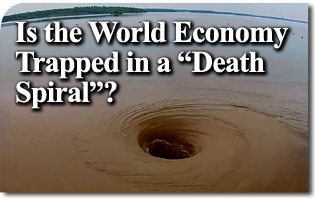 Everybody is looking for ways to describe the dire state of the world economy.
Everybody is looking for ways to describe the dire state of the world economy.
Some have used Crisis with a capital C, a sinking Titanic or a perfect storm. These are all dramatic expressions to describe a very serious situation. However, the latest metaphor being used is even more dramatic. Leading economists are talking about being trapped in a “death spiral.”
A February 4 report by Citi market strategists chronicles “a circular reference death spiral,” caused by a strong dollar, weaker oil/commodity prices, recession and serious equity problems. It is not just a single sequence of these factors that is happening, but a downward succession of recurring factors that calls to mind the death spiral metaphor.
All this means the world economy is in big trouble. Particularly worrisome is what some are calling the coming “Oilmageddon” — yet another apocalyptical reference.
Crude oil prices have plummeted some 70 percent since the middle of 2014. Since oil is traded in American dollars, the recent rise of the dollar by more than 20 percent against a basket of world currencies has compounded the crisis. In addition, bad news from China’s slowing and debt-ridden economy is weighing heavily on global prospects for growth. Above all, economists fear that America will enter into recession, which will have worldwide repercussions.
As a result, forecasts for global growth are down significantly. Policymakers everywhere, especially in emerging countries, have thrown all sorts of emergency measures and stimuli at the crisis. They are running out of tools from the Keynesian toolbox to “fix” the crisis.
Jonathan Stubbs, head of the team that produced the Citi study, believes these policymakers must try to “regain credibility” over the coming months so as to avoid a full global recession and “dangerous disorder across financial markets.”
“The stakes are high,” Stubs claims, “perhaps higher than they have ever been in the post-World War II era.”
The irony of the situation is that the present world capital-C Crisis is not the result of shortcomings, scarcity, or lack of economic production. The alarming threats found in works like Paul Ehrlich’s “The Population Bomb” (1968) have not come to pass. The planetary ecosystem is not reaching the limits of what it can sustain.
Quite the contrary, the economic system is working just fine. There is plenty of everything – oil, metals, and food. Nations have been gorging themselves on low-interest credit to the point of destabilizing markets. Grains and foodstuff are also plentiful and cheap. Overabundance is the problem. Economists are complaining that inflation rates are too low and deflation, not inflation, is a danger.
The present capital-C Crisis points to a system that is frenzied and out of balance. There is what might be called a frenetic intemperance in markets whereby people are compelled to desire everything, instantly, and effortlessly. This intemperance has turned the world economy into a party economy that never seems to stop; it has built up a credit card culture with an ever-increasing spending limit and monthly payment.
To use a comparison, the global market economy is like a very healthy and robust human body. It is capable of working hard and generating an enormous amount of wealth. But there is also a drug called frenetic intemperance that enters into the veins of this healthy body and wreaks havoc upon its systems. It can even stimulate the muscles to work harder and make the body hyperactive, but it creates an enormous imbalance that frequently causes the whole system to crash.
The present problem is that this drug of frenetic intemperance is undermining and now dominating a robust global economy; it’s spiraling out of control. Is it a death spiral? Only time will tell, but meanwhile, we are running out of metaphors.
As seen on The Blaze.
